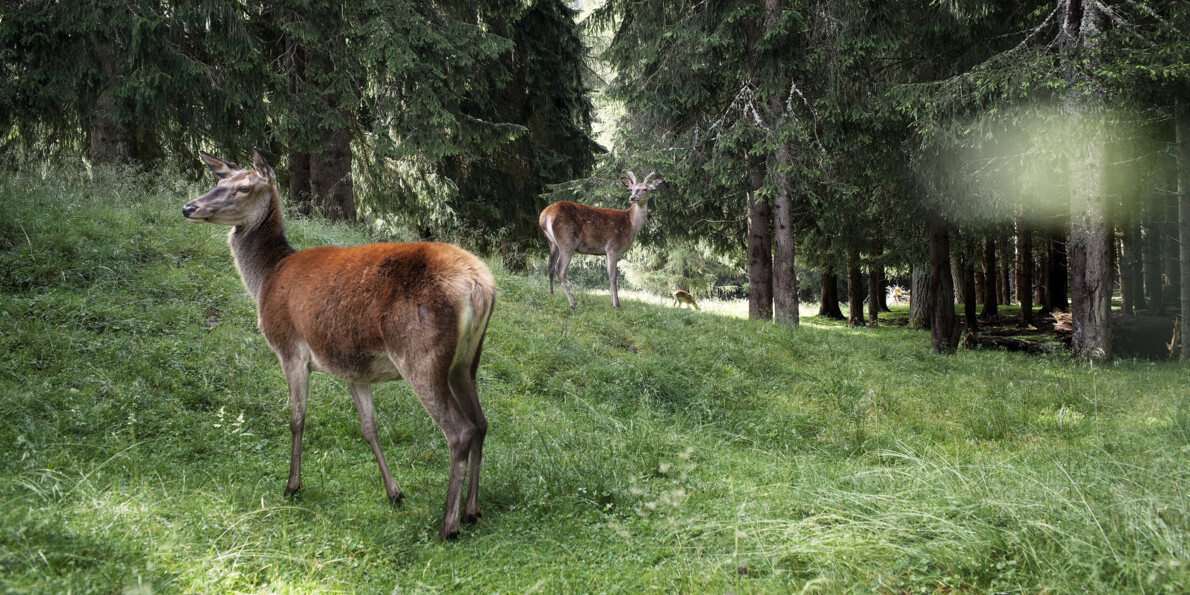67 THOUSAND CHAMOIS, ROE DEER AND DEER
In a territory like Trentino, 30% of which is subject to some form of protection, being able to maintain a high degree of biological diversity is fundamental in order to preserve biodiversity, stabilise ecosystems or, more simply, keep the environment in good health.
As we travel within this biodiversity treasure trove we may switch in just a few kilometres from the intense Mediterranean scents of the Upper Garda to the majesty of high altitude glacial environments, discovering a flora with abundant endemic species (especially in some areas of the Ledro Alps and on Monte Baldo), a rich population of nesting birds and a wild fauna that is unmatched in the Alps: 30 thousand roe-deer, 27 thousand chamois, 10 thousand deer, 50 bears (these latter are the result of the most ambitious and challenging fauna restocking project ever completed in Europe), 60 golden eagle pairs, steinbocks, bearded vultures and lynxes, which have recently reappeared. All the more impressive a result if we consider that 530,000 people live and work in Trentino: a bet won for the coexistence of man and wild fauna.
Among the environments that best characterize Trentino landscapes are the forests, with a wide diversity of vegetation types and a particularly rich and diversified fauna including species highly representative of the Alpine world. Forest environments host a considerable variety of birds species of interest to the European Community, often present in significant numbers. Woods, also thanks to the large area covered, are also extremely valuable environments for mammals: the good numbers of ungulates (deer and roe-deer), the presence of species of considerable ecological interest like the marten and the successful reintroduction of brown bears are the most tangible signs of environmental quality. The overall wild character of the forests is evidenced by the great number of nesting birds species, well represented by diurnal and nocturnal birds of prey, with some species of clear ecological significance like the goshawk, buzzard, honey-buzzard, pigmy owl and Tengmaln’s owl, and the long-eared owl commonly found in fir and larch tree forests. The number of woodpeckers is also a good indicator of the wild character of Trentino woods. Mixed conifer forests are the habitat of capercaillie and hazel hen, two protected species. The presence of amphibians and reptiles, compared to the valley floors, was favoured by the maintenance of clearings, bogs, ponds, watering holes and detrital areas, and by a general environmental diversification.
Cliffs and rocky slopes are an important environment for wild fauna, especially for the nesting of numerous bird species, many of which receive the attention of the European community as strongly endangered species. Medium and high altitude rocky environments are also valuable wildlife areas characterised by a great variety of species. Here the greatest numbers of diurnal birds of prey are found (buzzard, honey buzzard, kestrel, peregrine hawk), as well as many nesting sites of golden eagles (especially in prealpine areas), but also ravens and short-toed eagles, almost disappeared in the 80s and now increased considerably in number. These environments are also characterised by the presence of several species of bats, occupying natural and artificial cavities and giving rise to summer and winter colonies.
Many species inhabiting high altitude environments are considered good bioindicators, as they are potentially sensitive to the effects of climate changes, in particular global warming and mountain depopulation. That is the case for snow-grouse, Alpine accentor, snow finch, rock thrush, black grouse and Greek partridge in the Prealps and, among mammals, the mountain hare. Golden eagles are currently present with about 60 pairs. Amphibians and reptiles are less numerous at high altitudes, with typical high altitude species being the viviparous lizard and the adder. Among the most frequently seen species, marmots are considered an important indicator of natural wildlife in the Trentino mountains. Steinbocks, thanks to several reintroduction interventions, are now up to 350 head.



